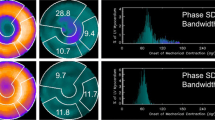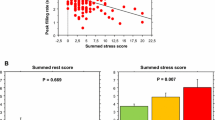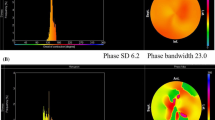Summary
Background
In the diagnosis of coronary artery disease (CAD) with Dobutamine Stress Echocardiography (DSE), regional wall motion abnormalities (RWMA) are assumed to indicate a perfusion deficit.
Methods and results
For a more particular examination of RWMAs, we compared simultaneous echo-contrast (Optisone®)-enhanced DSE (0–40 µg/kg Dobutamine, 16-segment- model) and MiBi-SPECT in a prospective double-blinded study design in 69 non-selected consecutive patients (44 male, 25 female, age 64±12 years). Additionally, all patients were examined by coronary-angiography. The prevalence of significant CAD (stenosis >50% lumen diameter) was 52%. DSE had a sensitivity of 78% and a specificity of 66% for the detection of significant CAD with a positive and negative predictive value of 72 and 73%, respectively. Among 28 patients with significant CAD and positive DSE study (true positive), 78% displayed a corresponding perfusion deficit in MiBi-SPECT. Among 11 patients with a positive DSE study but no current significant coronary stenosis (false positive), 82% showed stress-induced RWMAs in the inferior/ posterior region, 73% displayed left ventricular hypertrophy, 54% resting-ECG abnormalities and 45% resting-RWMA (3 previous MI, 2 previous CABG surgery). Among 8 patients with negative DSE study but significant coronary stenosis (false negative), 75% had a stenosis of the LCX, 63% displayed resting- WMA, 63% displayed left bundle branch block or ST-segment depression, 50% displayed only peripheral coronary stenosis, and DSE visualization was suboptimal in 38%.
Conclusion
This prospective study in non-selected patients shows that the majority of RWMAs in DSE are matched to a perfusion deficit detectable by nuclear imaging. Nevertheless, pre-existing cardiac abnormalities may also lead to stress-induced RWMA not associated with a perfusion deficit or mask a perfusion deficit upon DSE. Particularly in patients with LV hypertrophy, resting-RWMA, bundle branch block or ST segment depression, the predictive value of DSE may, therefore, be limited.
Similar content being viewed by others
References
Marwick T, D’Hondt A, Baudhuin T, Wijns W, Detry JM, Melin J (1993) Optimal use of dobutamine stress for the detection and evaluation of coronary artery disease: combination with echocardiography or scintigraphy, or both? J Am Coll Cardiol 22(1):159–167
Foster T, NcNeill AJ, Salustri A, Reijs AE, el Said ES, Roelandt JR, Fioretti PM (1993) Simultaneous dobutamine stress echocardiography and technetium 99m-isonitrile single-photon emission computed tomography in patients with suspected coronary artery disease. J Am Coll Cardiol 21(7):1591–1596
Nesto RW, Kowalchuck GJ (1987) The ischemic cascade: temporal sequence of hemodynamic, electrographic and symptomatic expressions of ischemia. Am J Cardiol 57:23C–27C
Elhendy A, Geleijnse ML, Roelandt JR, van Domburg RT, Ten Cate FJ, Nierop PR, Bax JJ, El-Refaee M, Ibrahim MM, El-Said GM, Fioretti PM (1997) Comparison of dobutamine stress echocardiography and 99mtechnetium sestamibi SPECT myocardial perfusion scintigraphy for predicting extent of coronary artery disease in patients with healed myocardial infarction Am J Cardiol 79:7–12
Fragasso G, Lu C, Dabrowski P, Pagnotta P, Sheiban I, Chierchia SL (1999) Comparison of stress/rest myocardial perfusion tomography, dipyridamole and dobutamine stress echocardiography for the detection of coronary artery disease in hypertensive patients with chest pain and positive exercise test. J Am Coll Cardiol 34(2):441–447
Lancelotti P, Benoit T, Rigo P, Pierad LA (2001) Dobutamine stress echocardiography versus quantitative tecnetium- 99-m sestamibi SPECT for detecting residual stenosis and multivessel disease after myocardial infarction. Heart 86(5):510–515
Elhendy A, van Domburg RT, Bax JJ, Nierop PR, Geleijnse ML, Ibrahim MM, Roelandt JR (1998) Noninvasive diagnosis of coronary artery disease in women with limited exercise capacity. Chest 144(4):1097–1104
Senior R, Sridhara BS, Anagnostou E, Handler C, Raferty EB, Lahiri A (1994) Synergistic value of simultaneous stress dobutamine sestamibi single-photon emission computerized tomography and echocardiography in the detection of coronary artery disease. Am Heart J 128:713–718
Schinkel AFL, Bax JJ, Geleijnse ML, Boersma E, Elhendy A, Roelandt JR, Poldermans D (2003) Noninvasive evaluation of ischemic heart disease: myocardial perfusion imaging or stress echocardiography? Eur Heart J 24:789–800
Dolan MS, Riad K, El-Shafei A, Puri S, Tamirisa K, Bierig M, St. Vrain J, McKinney L, Havens E, Habermehl K, Pyatt L, Kern M, Labovitz AJ (2001) Effect of intravenous contrast for left ventricular opacification and border definition on sensitivity and specificity of dobutamine stress echocardiography compared with coronary angiograpy in technically difficult patients. Am Heart J 142(5):908–915
Rainbird AJ, Mulvagh SL, Oh JK, McCully RB, Klarich KW, Shub C, Mahoney DW, Pellikka PA (2001) Contrast dobutamine stress echocardiography: clinical practice assessment in 300 consecutive patients. J Am Soc Echocardiogr 14(5):378–385
Geleijnse ML, Elhendy A, van Domburg RT, Cornel JH, Rambaldi R, Salustri A, Reijs AE, Roelandt JR, Fioretti PM (1997) Cardiac imaging for risk stratification with dobutamineatropine stress testing in patients with chest pain. Echocardiography, perfusion scintigraphy, or both? Circulation 96:137–147
Vasu MA, O’Keefe DD, Kapellakis GZ (1978) Myocardial oxygen consumption: effects of epinephrine, isoproterenol, dopamine, norepinephrine and dobutamine. Am J Physiol 235:H237–H241
Geleijnse ML, Marwick TH, Boersma E (1995) Optimal pharmacological stress testing for the diagnosis of coronary artery disease: a probabilistic approach. Eur Heart J 16(Suppl M):3–10
Fung AY, Gallagher KP, Buda AJ (1997) The physiologic basis of dobutamine as compared with dipyridamole stress interventions in the assessment of critical coronary artery stenosis. Circulation 76:943–951
Elhendy A, van Domburg RT, Bax JJ, Poldermans D, Nierop PR, Kasprzak JD, Roelandt JR (1998) Optimal criteria for the diagnosis of coronary artery disease by dobutamine stress echocardiography. Am J Cardiol 82:1339–1344
Bach D, Muller DWM, Gros BJ, Armstrong WF (1994) False positive dobutamine stress echocardiograms: characterisation of clinical, echocardiographic and angiographic findings. J Am Coll Cardiol 24:928–933
Latcham AP, Orsinelli DA, Pearson AC (1995) Recognition of the segmental tendency of false positive dobutamine stress echocardiography and its effects on test sensitivity and specificity. Am Heart J 129:1047–1050
Spencer KT, Bednarz J, Rafter PG, Korcarz C, Lang RM (1998) Use of harmonic imaging without echocardiographic contrast to improve twodimensional image quality. Am J Cardiol 82:794–799
Ha JW, Juracan E, Mahoney DW, Oh JK, Shub C, Seward JB, Pellikka P (2002) Hypertensive response to exercise: a potential cause for new wall motion abnormality in the absence of coronary artery disease. J Am Coll Cardiol 39(2):323–327
Marwick TH (1996) Cardiac stress testing and imaging. A clinician’s guide. Chruchill Livingstone, New York
Pozzoli MM, Fioretti PM, Salustri A, Reijs AE, Roelandt JR (1991) Exercise echocardiography and technetium 99m MIBI single photon emission computed tomography in the detection of coronary artery disease. Am J Cardiol 67:350–355
Sawada SG, Segar DS, Ryan T (1991) Echocardiographic detection of coronary artery disease during dobutamine infusion. Circulation 83:1605– 1614
Houghton JL, Frank JM, Car AA (1990) Relations among impaired coronary flow reserve, left ventricular hypertrophy and thallium perfusion defects in hypertensive patients without obstructive coronary artery disease. J Am Coll Cardiol 15:43–51
DePeuy EG, Guertler-Krawczynska E, Perkins JV (1988) Alterations in myocardial tallium-201 distribution in patients with chronic systemic hypertension undergoing single-photon emission computed tomography. Am J Cardiol 62:234–238
Elhendy A, Geleijnse ML, van Domburg RT (1998) Comparison of dobutamine stress echocardiography and technetium-99m sestamibi singlephoton emission tomography for the diagnosis of coronary artery disease in hypertensive patients with and without left ventricular hypertrophy. Eu J Nucl.Med 25:69–78
Oraby MA, Hays J, Maklady FA, El- Hawary AA, Zabalgoitia M (2002) Assessment of myocardial perfusion during pharmacologic contrast stress echocardiography, Am J Cardiol 89:640–644
von Bibra H, Bone D, Voigt J-U, Niklasson U, Wranne B, Rydén L (2000) Kontrastechokardiographie. Z Kardiol 89:86–96
Hardt SE, Pekrul I, Hansen A, Gebhard M, Kuebler W, Kuecherer HF (2001) Differential value of adenosine myocardial contrast echocardiography and dobutamine stress echocardiography in evaluating functional significance of coronary artery stenosis in a porcine model. Basic Res Cardiol 96:415–421
Author information
Authors and Affiliations
Corresponding author
Rights and permissions
About this article
Cite this article
Heinicke, N., Benesch, B., Kaiser, T. et al. Mechanisms of regional wall motion abnormalities in contrast-enhanced Dobutamine Stress Echocardiography. Clin Res Cardiol 95, 650–656 (2006). https://doi.org/10.1007/s00392-006-0443-2
Received:
Accepted:
Published:
Issue Date:
DOI: https://doi.org/10.1007/s00392-006-0443-2




